

Helena Hamilton sur Twitter : "Image from today's interactive sound performance 'But...' @sonorities @SARC #soundart #MaxMSP #Belfast #livedrawing. Helena Hamilton sur Twitter : "Yesterday's interactive sound performance 'Untitled (When)' @sonorities @SARC #soundart #MaxMSP. Helena Hamilton sur Twitter : "Start tidying this patch up #maxmsp #interactive #soundart... Helena Hamilton sur Twitter : "Prep for @sonorities launch on Fri 17th April @GoldsmithsUoL @SARC @ArtsCouncilNI #Belfast #London #soundart. Helena Hamilton on Instagram: “OHP number 2...let's build an orchestra! #soundart #belfast” Helena Hamilton sur Twitter : "Re-working interactive sound piece - performing in London and Belfast next month #soundart #art @ArtsCouncilNI. Instagram. The Butterflies In My Brain - Live performance/improvisation @Sonorities 02/05/2014 by HelenaHamilton.
Helena Hamilton sur Twitter : "Nice article and mention of my work @VisArtsIreland last issue (issue 5), Sound Art in Belfast #soundart #belfast. Helena Hamilton sur Twitter : "Performing a sound piece @BlackBoxBelfast this Thurs part @FlaxArtStudios 25th anniversary symposium #soundart #OHP. The Butterflies In My Brain - Live performance/improvisation @pssquared, Belfast 18/06/14 by HelenaHamilton.
La Semaine du Son 2010 - Murray Schafer. Sensuous Geographies: Body, Sense and Place - Paul Rodaway. New!
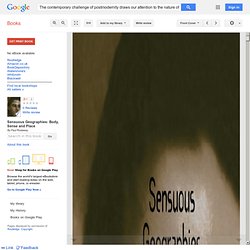
Drag and drop to rearrange your apps. Sign in to try it. MoreEven more from Google Sign in Books Add to my library Write review Front Cover Link. WORLD SOUNDSCAPE PROJECT. The World Soundscape Project (WSP) was established as an educational and research group by R.
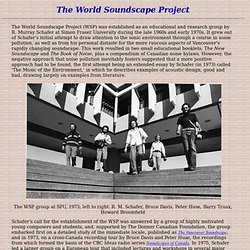
Murray Schafer at Simon Fraser University during the late 1960s and early 1970s. It grew out of Schafer's initial attempt to draw attention to the sonic environment through a course in noise pollution, as well as from his personal distaste for the more raucous aspects of Vancouver's rapidly changing soundscape. This work resulted in two small educational booklets, The New Soundscape and The Book of Noise, plus a compendium of Canadian noise bylaws. However, the negative approach that noise pollution inevitably fosters suggested that a more positive approach had to be found, the first attempt being an extended essay by Schafer (in 1973) called 'The Music of the Environment,' in which he describes examples of acoustic design, good and bad, drawing largely on examples from literature. The WSP group at SFU, 1973; left to right: R.
Soundscapes. The British Library is developing its collection of soundscapes to support research. 'Soundscape' is an overarching term used to define sounds that are location specific and pertain to an acoustic identity of place.
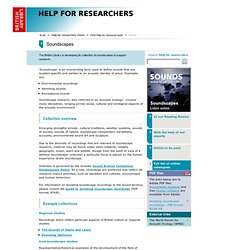
Examples are: Environmental recordingsVanishing soundsRecreational events. Biophony. Biophony (aka the niche hypothesis) consists of the Greek prefix, bio, meaning life, and the suffix, phon, meaning sound.
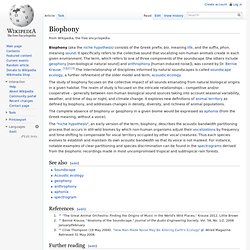
It specifically refers to the collective sound that vocalizing non-human animals create in each given environment. The term, which refers to one of three components of the soundscape (the others include geophony [non-biological natural sound] and anthrophony [human-induced noise]), was coined by Dr. Bernie Krause. [1][2] [3] The interrelationship of disciplines informed by natural soundscapes is called soundscape ecology, a further refinement of the older model and term, acoustic ecology. The study of biophony focuses on the collective impact of all sounds emanating from natural biological origins in a given habitat. Quiet american. I made my first work from field recordings in the fall of 1998.
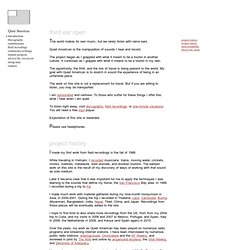
While traveling in Vietnam, I recorded musicians, trains, moving water, crickets, monks, markets, metalwork, tired animals, and drunken tourists. The earliest work on this site is the result of my discovery of ways of working with that sound as sole medium. Later it became clear that it was important for me to apply the techniques I was learning to the sounds that define my home, the San Francisco Bay area. In 1999 I recorded during a trip to Fiji. THE MATERIAL IMAGINATION: Sound, Space, and Human Consciousness. SOUNDSCAPE EXPLORATIONS. A short history of Acoustic Ecology. From left: Chris Wood, Nathan Clarkson and Camara Miller.
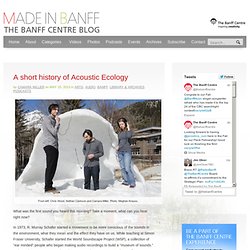
Photo: Meghan Krauss. What was the first sound you heard this morning? Take a moment, what can you hear right now? World Forum for Acoustic Ecology. ACOUSTIC ECOLOGY. Back to David Dunn main page The Sound of Light in Trees: The Acoustic Ecology of Pinyon Pines David Dunn's new CD is now out!
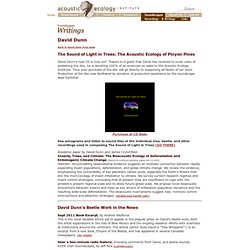
Thanks to a grant that David has received to cover costs of publishing the disc, he is donating 100% of all revenues on sales to the Acoustic Ecology Institute. Thus your purchase of the disc will go directly to supporting all facets of our work. Production of the disc was facilitated by donation of production assistance by the soundscape label EarthEar. Barry. Granular Synthesis. High and low frequency grains What is most remarkable about the technique is the relation between the triviality of the grain (heard alone it is the merest click or 'point' of sound) and the richness of the layered granular texture that results from their superimposition.
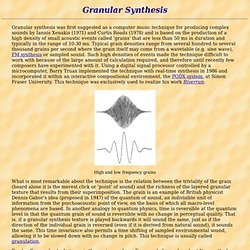
The grain is an example of British physicist Dennis Gabor's idea (proposed in 1947) of the quantum of sound, an indivisible unit of information from the psychoacoustic point of view, on the basis of which all macro-level phenomena are based. In another analogy to quantum physics, time is reversible at the quantum level in that the quantum grain of sound is reversible with no change in perceptual quality. That is, if a granular synthesis texture is played backwards it will sound the same, just as if the direction of the individual grain is reversed (even if it is derived from natural sound), it sounds the same.
Key to all granular techniques is the grain envelope. Granular Synthesis: Resource Site. Acoustic Ecology + Soundscape Composition...Quotes by BRANDON LABELLE. johnroach.net/wordpress/lab/files/2011/07/I-have-never-seen-a-sound.pdf. R. MURRAY SCHAFER - I HAVE NEVER SEEN A SOUND - Quotes. Sound Sculpture... Bill Fontana Sound Sculptures. Organ of Corti - full length version. Bernhard Leitner: Sound Spaces. “I can hear with my knee better than with my calves.”
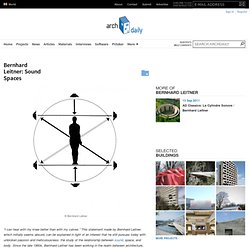
This statement made by Bernhard Leitner, which initially seems absurd, can be explained in light of an interest that he still pursues today with unbroken passion and meticulousness: the study of the relationship between sound, space, and body. Since the late 1960s, Bernhard Leitner has been working in the realm between architecture, sculpture, and music, conceiving of sounds as constructive material, as architectural elements that allow a space to emerge. Sounds move with various speeds through a space, they rise and fall, resonate back and forth, and bridge dynamic, constantly changing spatial bodies within the static limits of the architectural framework. Idiosyncratic spaces emerge that cannot be fixed visually and are impossible to survey from the outside, audible spaces that can be felt with the entire body.
MAX NEUHAUS. Max Neuhaus. Max Neuhaus. Times Square, 2002. Environments (series) Environments is a series of LPs, cassettes, 8-Track cartridges and CDs created by producer and sound recordist Irving Solomon Teibel (1938-2010[1]) for Syntonic Research Inc. between 1970 and 1979.
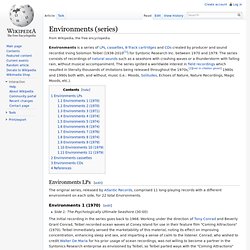
The series consists of recordings of natural sounds such as a seashore with crashing waves or a thunderstorm with falling rain, without musical accompaniment. The series ignited a worldwide interest in field recordings which resulted in literally thousands of imitations being released throughout the 1970s,[2][not in citation given] 1980s and 1990s both with, and without, music (i.e.: Moods, Solitudes, Echoes of Nature, Nature Recordings, Magic Moods, etc.). The original series, released by Atlantic Records, comprised 11 long-playing records with a different environment on each side, for 22 total Environments. Side 1: The Psychologically Ultimate Seashore (30:00) Audio Culture, Readings in Modern Music. Chapter 2 - LUIGI RUSSOLO - The Art of Noises: Chapter 3 - MORTON FELDMAN - Sound, Noise, Amazon.co. Stockhausen on 'sounds', 1972. John Cage about silence. Musical Sculpture - Marcel Duchamp. Music, TOUT-FAIT: The Marcel Duchamp Studies Online Journal. Erratum Musical, 1913 by Ya-Ling Chen One can look at seeing; one can not hear hearing.
Schaeffer + Schafer...Quote by BRANDON LABELLE. Michel Chion. Michel Chion born in 1947 in Creil, France, is a composer of experimental music. He teaches at several institutions within France and currently holds the post of Associate Professor at the University of Paris III: Sorbonne Nouvelle where he is a theoretician and teacher of audio-visual relationships. After studying literature and music he began to work for the ORTF (French Radio and Television Organisation) Service de La recherche as assistant to Pierre Schaeffer in 1970. He was a member of the Groupe de Recherches Musicales (GRM) between 1971 - 1976. His compositional pieces elaborate on schaeffarian theories and methodologies which Schaeffer referred to as musique concrète. He has also written a number of books as well as essays expounding his theories of the interaction between sound and image within the medium of film.
In particular, the book titled L’audio-vision. Writings[edit] 1982. Recordings[edit] ems.music.utexas.edu/program/mus329e/assignments/reading/three_modes_of_listening.pdf.